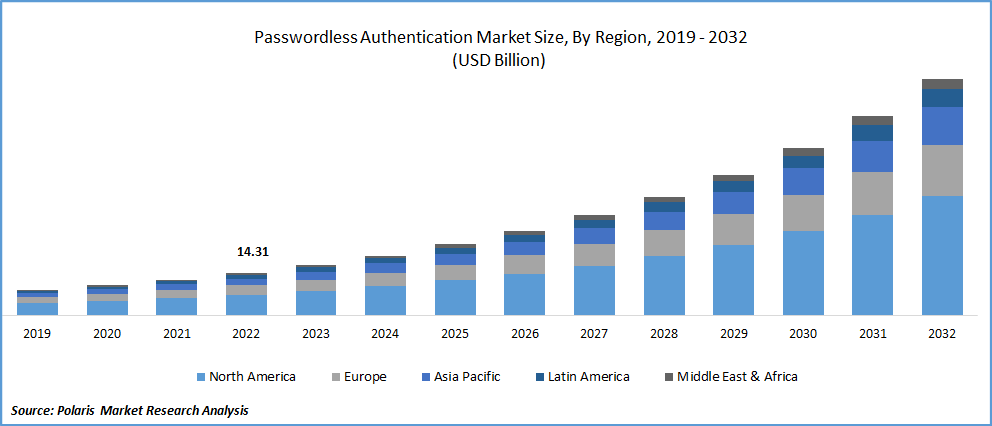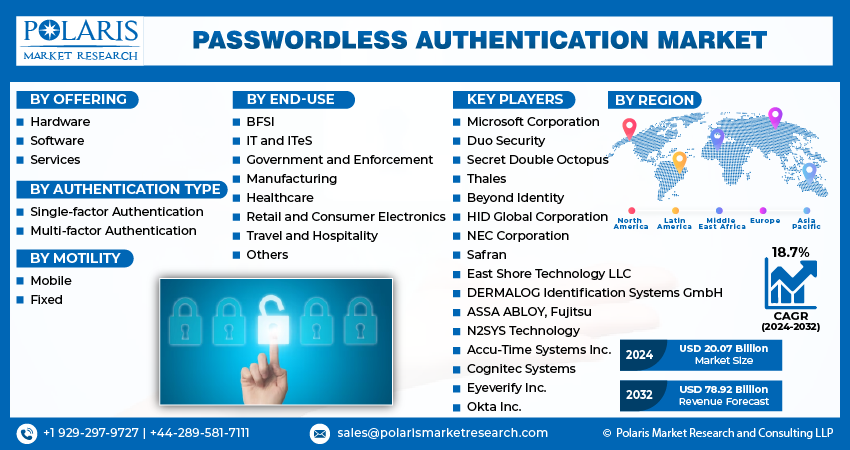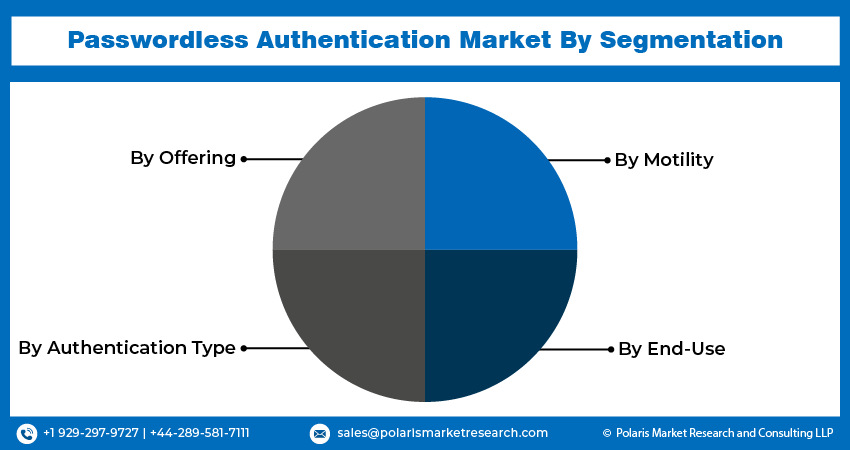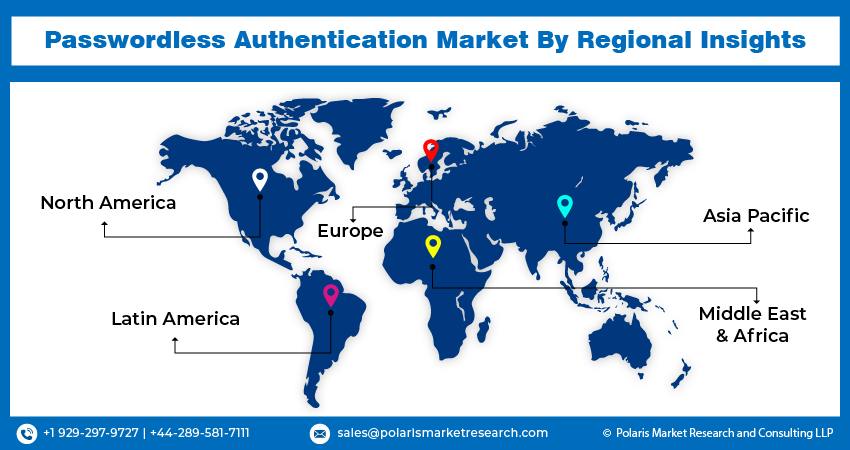
Passwordless Authentication Market Share, Size, Trends, Industry Analysis Report, By Offering (Hardware, Software, and Services); By Authentication Type; By Motility; By End-Use; By Region; Segment Forecast, 2024 - 2032
- Published Date:Jan-2024
- Pages: 119
- Format: PDF
- Report ID: PM3158
- Base Year: 2023
- Historical Data: 2019-2022
Report Outlook
The global passwordless authentication market was valued at USD 16.95 billion in 2023 and is expected to grow at a CAGR of 18.7% during the forecast period. The increasing penetration for smartphones and many other consumer electronic devices along with the high need and prevalence for an additional layer of security beyond passwords and widespread adoption of technologies like facial recognition and fingerprint recognition across various industries including BFSI, government, healthcare, and manufacturing, are prominent factors propelling the growth of the global market.

Know more about this report: Request for sample pages
In addition, many companies worldwide are focusing on the improvement and enhancement of authentication systems to tackle the growing concerns regarding fraudulent transactions, that is anticipated to create huge growth opportunities in the coming years.
For instance, in December 2022, Google Chrome, launched of its latest passwordless secure login through passkeys, a unique identity that is stored on user computer, phones, and tablets just like a USB security key that does not require any password.
The outbreak of the COVID-19 pandemic has positively impacted the growth of the passwordless authentication market. The rapid spread of the deadly coronavirus caused various organizations to switch form their traditional workplace to online or remote working, due to which more unsecured personal systems has been given to a company, the risk and danger of security breaches increased significantly by making the network more susceptible to the hackers. Thus, the adoption of secure authentication systems was increasing rapidly to tackle these fraudulent activities.
Industry Dynamics
Growth Drivers
The extensive rise in the adoption of adaptive authentication especially in developed countries like US, Canada, Germany, and France, as these systems uses behavioral and environmental factors to evaluate the danger associated with an access attempts, is major factor influencing the growth of the global passwordless authentication market. Adaptive systems are mainly used due to its ability to identify potentially risky behavior by using a range of behavior-measuring strategies along with the location.
Furthermore, the rapidly growing prevalence for the integration of technologies such as artificial intelligence, internet of things, cloud computing, and others in variety of devices like smartphones and tablets are also projected to boost the growth of the global market in the coming years. Additionally, fingerprint sensors and smartcards are widely used to verify identities and these solutions allows for a seamless experience and create path for smooth flow of data between points.

Report Segmentation
The market is primarily segmented based on offering, authentication type, motility, end-use, and region.
|
By Offering |
By Authentication Type |
By Motility |
By End-Use |
By Region |
|
|
|
|
|
Know more about this report: Request for sample pages
Hardware segment accounted for largest market share in 2022
Users across the globe are highly utilizing hardware-based security devices to perform their authentication with the help of cryptographically secure software. In addition, high prevalence among large enterprises regarding the numerous benefits of these authentication types, while knowing that their data is completely safe and secure and compatible with global security requirements, which results in higher adoption and positive market growth.
Multi-factor authentication segment is projected to grow at fastest CAGR over he forecast period
The multi-factor authentication segment is expected to grow at highest CAGR during the projected period, which is mainly driven by rapid increase in identity theft and breach, growth in the usage of IoT devices across several applications, and stringent government regulations undertaken by several governments across the globe.
Large organizations are implying on strict identity verification methods for the better protection of sensitive data and high penetration to reduce the unauthorized logins and fraudulent transactions by forcing users to confirm their security form different factors including fingerprint scanning, face recognition, and iris scanners. Thus, to cater this growing demand for advanced authentication solutions many companies are focusing on developing new and more innovative solutions, which is likely to contribute significantly to the segment growth in the coming years.
Fixed segment held the significant market share in 2022
The fixed segment led the market on account of widespread use of biometric infrastructure for time management and attendance systems especially in the business sector. Additionally, easy availability of these systems and their cost-effectiveness as compared to other authentication solutions available in the market makes them a preferable choice among users.
Furthermore, the mobile segment is expected to grow at fastest growth rate over the projected period. Mobile authentications systems are freely movable and can be easily carry out anywhere because they do not necessitate as comprehensive a fixed authentication system and it also include various capabilities like Wi-Fi and remote operations, that allow users to monitor and operate their system form any locations, which is propelling the growth of the segment market at rapid pace.
Government and enforcement segment dominated the global market in 2022
The growth of the segment can be attributed to heavily increasing investment in variety of digital programs as internet services are gaining traction as primary communication between citizen and governments. The security of government digital services is one of the major problems prompting agencies to reconsider regarding their national authentication systems and improve them, that is creating high demand and pushing market growth forward.
However, the BFSI segment is anticipated to expand at significant growth in the forecast period, as many financial organizations across the glove are adopting passwordless authentication to achieve greater heights and scale their businesses by granting user access to more password-protected data.

The demand in Asia Pacific region is projected to witness highest growth
The Asia Pacific region is expected to witness highest rate of growth during the projected period, which is mainly accelerated by growing penetration for the usage of smartphone and tablets and adoption of many innovated technology including facial recognition and fingerprint recognition in the region. Moreover, increasing need to enable employees, partners, and other stakeholders to access ore secure and sensitive information from anywhere across several enterprises, is fueling the adoption and demand across the region.
North America garnered the largest share, in 2022, and is expected to maintain its dominance over the study period. The growth of the regional market can be attributed to wide range of advantages including improved user experience, high security, low ownership cost, and significantly growing investments in developed countries like US and Canada for the implementation of R&D activities related to advanced authentication systems.

Competitive Insight
Some of the major players operating in the global market include Microsoft Corporation, Duo Security, Secret Double Octopus, Thales, Beyond Identity, HID Global Corporation, NEC Corporation, Safran, East Shore Technology LLC, DERMALOG Identification Systems GmbH, ASSA ABLOY, Fujitsu, N2SYS Technology, Accu-Time Systems Inc., Cognitec Systems, Eyeverify Inc., Okta Inc., and Prove.
Recent Developments
- In November 2022, Microsoft, announced the launch of passwordless authentication for Azure AD on iOS and Android, that enables through YubiKey hardware security key, developed by Yubico. With this new solution, users will be able to provision certificates with a hardware security key, that allow them to authenticate easily on mobile devices.
- In October 2022, Prove introduced its latest authentication solution named Prove Auth, a next-generation solution for omni-channel authentication & passwordless authentication. It enables companies to reduce their reliance on the passwords and also on-time passcodes and empowering users to authenticate in all channels such as phones, & desktop.
Passwordless Authentication Market Report Scope
|
Report Attributes |
Details |
|
Market size value in 2024 |
USD 20.07 billion |
|
Revenue forecast in 2032 |
USD 78.92 billion |
|
CAGR |
18.7% from 2024 – 2032 |
|
Base year |
2023 |
|
Historical data |
2019 – 2022 |
|
Forecast period |
2024 – 2032 |
|
Quantitative units |
Revenue in USD billion and CAGR from 2024 to 2032 |
|
Segments covered |
By Offering, By Authentication Type, By Motility, By End-Use, By Region |
|
Regional scope |
North America, Europe, Asia Pacific, Latin America; Middle East & Africa |
|
Key companies |
Microsoft Corporation, Duo Security, Secret Double Octopus, Thales, Beyond Identity, HID Global Corporation, NEC Corporation, Safran, East Shore Technology LLC, DERMALOG Identification Systems GmbH, ASSA ABLOY, Fujitsu, N2SYS Technology, Accu-Time Systems Inc., Cognitec Systems, Eyeverify Inc., Okta Inc., and Prove. |
FAQ's
The passwordless authentication market report covering key segments are offering, authentication type, motility, end-use, and region.
Passwordless Authentication Market Size Worth $78.92 Billion By 2032.
The global passwordless authentication market expected to grow at a CAGR of 18.6% during the forecast period.
Asia Pacific is leading the global market.
Key driving factors in passwordless authentication market are increasing use of smartphones and other consumer electronics.
